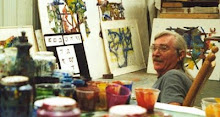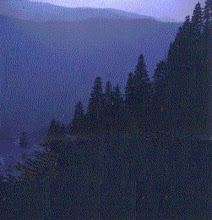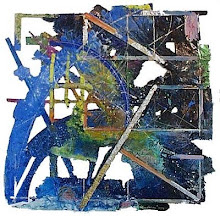Two works from the Beowulf Cycle:
"So Grendal Ruled in Defiance (2002) charcoal on paper":
"Wall Stead - In Heorot" (2010), oil on paper 12"h. x 30"w.:
A new friend wrote me saying these works reminded him of Rothko and Mondrian. Certainly. But I was hunting after something grimmer, with the teeth of wild dogs in the night - something in the silence after you hear the howling stop at midnight up on the ridge above my house; something old, very old, yet something still with us.
After all, this cycle of works was born out of that long time after September 11, 2001 when we all struggled with what terror means in our lives, some of us for the first time. The television repeated a thousand times over the long shot clips up the Manhattan canyons of the falling towers and the close up shots of frightened people fleeing wearing cloaks of the ashes of thousands of others. But the t.v. was impotent to tell of what it meant. That we each had to do ourselves. And we had to do this midst a storm of words generated by the media afterward, including the absurdity of our President exhorting us to just go out and fly and buy!
We don't see those t.v. clips much any more of course - that sense of horror can't be maintained. Through repetition we became numbed, but the sense of it drives deep within us into subterranean rivers. There it flows with our deepest fears and desires. Only later does it push up in new springs to the surface, where we drink of it in the form of revenge or hate, distrust, shame, alienation, estrangement and disaffection.
In the hollowed out days following the terrorist attack, I too struggled with some way to understand what had happened, and what, in its aftermath, was happening to my country. Of course, I went to the studio, picked up the deepest black stick of charcoal I could find, and began to draw.
A month and a half later my sister gave me a new translation of the 8th Century Anglo Saxon poem Beowulf by the Irish poet Seamus Heaney. It stunned me. Here was a clear sense of where to take this work: the starkly hewn way it carves and holds in constant balance line by line a palpable sense of light and dark, beginnings and ends, the ephemeral interlacing of humankind and nature, the way a line welds together a descriptive fact about nature with an evocation of human emotion, the way this energy is coiled and then released through succeeding lines like a driving wave. All these qualities resonated with my own confusion about what 9/11 meant, and suggested a "holding form" - that embryonic bud of a visual vocabulary, with which to explore toward some understanding.
It's now been over 8 years since that Tuesday morning in September. Some of us would like to forget. Some of us can't. As a country we are still trying to come to grips with what the presence of terror means in our lives. Our civic leaders have tried to turn it into a war - that way it is so much more understandable to a country gotten used to one war after another (after all, in my 65 years there have only been 10 when my country was not at war!). Our conflicts can't so easily be encapsulated I think except within the hollow pretense of newspapers, t.v., or on political stumps. The sources for our "wars" run fearfully deep within us - the Beowulf saga is a clear testament to that. We are at "war" with deep conflicts within ourselves, and we extend them not only to each other but to the natural world itself. It sometimes seems we are at war with the world at large, and the wall steads we have built to stand against disaster are falling all about us, like the mead hall in Beowulf's Heorot.
It's an old plaint and lamentation - the destruction of the world as we've known it. And in its destruction, the creation of something new.
Today I'm still exploring this work, still exploring my understanding of what it means through the work itself. It is called The Beowulf Cycle, and if you would like to see more examples just click here .
Subscribe to:
Post Comments (Atom)







Yes, perhaps your friend sees Mondrian and Rothko in the Beowulf pieces but I see other things. If i view the Grendal work as a floorplan I see the remnants of a structure, broken open and surrounded by snow. The marauding wolf has been there, dirtying up the snow in corners around the remnants of the foundation. Something has been opened up---a gate perhaps after the war. I see the second work as a front view of classic columns, marble steps, a wall as you say. It too is in ruins, but the way is not clear.
ReplyDelete